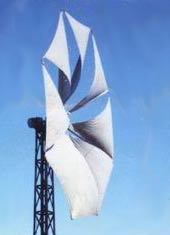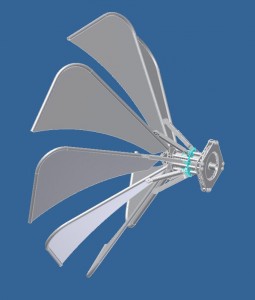Thus, the task of building a good wind turbine is transformed into a task to build the right kind of a wind turbine for a certain place and a certain consumer. Here it would be useful to do a research of the existing market and to define the goods and the bads of the designs available.
Now it’s necessary to set up some characteristics (preferably digital ones) and apply them to the regions of operation. The key characteristic of the operation area is its “productivity”, i.e. the quantity of energy which the wind potentially has. This “productivity” is rather good characterized by the wind speed in annual figures, for example. The CIS regions could be divided in three regions according to the annual average wind speed:
– lower than 3m/s
– from 3 to 5 m/s
– more than 5 m/s
At the same time one should keep in mind that the wind speed does not have an equal time distribution. For the CIS territory there is a general characteristic with light winds comprising 70-80% of the time, moderate winds – 15-20%, high winds – 5-7%, fresh gales – 2-3%, storms – 1%. As you can see the average wind speed is about 1-3 m/s. Storms are very rare. It stands to reason to keep in mind the light winds even if you have to stall or fold down your wind turbine when there is a high wind or a storm. The system of folding down a wind turbine when there’s a high wind complicates its design but it is the other side of the question.
Now it’s time to have a look at the offer. The great number of the models offered is two-, three- or four -bladed horizontal axis turbines of different sizes and power output. Multi-bladed turbines are less common. Companies offer various sets: from separate units to the full package including assembling and checkout on the customer’s site. Few models of the own made, many offers of imported machines – from Chinese to well-known European makers.
 If we look at the digital characteristic, it appears that the customer contract demand is gotten out at a speed of 8-15 m/s; at the same time the lowest wind speed (so called pull away speed) is 2.5-4 m/s. A bit different characteristics you can expect from multi-bladed and jib wind turbines. The lowest wind speed is 0.5-1.5 m/s. The peak power is at the speed of 6-20 m/s. The limit operating speed is 15-30 m/s. The difference between characteristics is mainly defined by “the filled-up” of the periphery spun by blades. When the blades rotate fast enough, the entire periphery is used rather efficiently and does not depend entirely on the quantity and surface of the blades. But in light winds multi-bladed and sail turbines have an obvious advantage. They have it all to catch the wind and are able to convert very low airflows into the useful yield. With the wind intensification they lose that advantage and with gales they’re outdone by the “bladers”. The friction loss grows along with the speed.
If we look at the digital characteristic, it appears that the customer contract demand is gotten out at a speed of 8-15 m/s; at the same time the lowest wind speed (so called pull away speed) is 2.5-4 m/s. A bit different characteristics you can expect from multi-bladed and jib wind turbines. The lowest wind speed is 0.5-1.5 m/s. The peak power is at the speed of 6-20 m/s. The limit operating speed is 15-30 m/s. The difference between characteristics is mainly defined by “the filled-up” of the periphery spun by blades. When the blades rotate fast enough, the entire periphery is used rather efficiently and does not depend entirely on the quantity and surface of the blades. But in light winds multi-bladed and sail turbines have an obvious advantage. They have it all to catch the wind and are able to convert very low airflows into the useful yield. With the wind intensification they lose that advantage and with gales they’re outdone by the “bladers”. The friction loss grows along with the speed.
Now let’s try to anchor wind turbine characteristics to the territory. It is clear that in the major part of the CIS territory “bladers” stand or work in half-force. And costal districts would make an exception. Just the same thing we can see in the consumers’ report. The wind machines fall short on expectations. The power output is not enough taking in account long periods of time.
There’s less experience gained with multi-bladed and wind sail machines but performance expectations and the experience at the disposal indicates it to be more effective over the major part of the CIS territory.
Maintenance issues and solutions
If we generalize the maintenance issues of the wind turbines, it makes only two – light winds and gales. Consumers get irritated watching the high-priced equipment stand idle because of the feeble wind of after it was damaged by the storm. Besides it is important to do the aftermath. Engineers underestimate the consequences of the dead time caused by the windcalm and overestimate consequences of the storm wind. As a matter of fact, any dead time means negative profit. Several weeks of windcalm could do much harm than a unit change within a few days after the turbine was damaged by a storm.
An increase of power limit is not an answer as well. If you buy a wind generator of the maximum capacity of 10kWt to let it generate only 2kWt, it would be a pricy buy to say the least. In the long run all the extra costs will be applied to the energy price.
On the other hand the potential to resist storm winds will also increase the cost as the design gets weighty. Maybe there is no need to resist a storm? The grass doesn’t fight it! It just falls on the ground just to rise when it’s all over. And a palm tree could give away its leaves but saves the trunk. The leaves will grow back again really quick.
 We could try to describe a perfect wind turbine:
We could try to describe a perfect wind turbine:
– simple generator head of a given power capable to work at a low speed;
– light blades of large surface area to harvest energy from the lowest wind;
– a system of folding down the blades in case of the wind intensification;
– a footing which allows to lower the generator with the blades in case the wind intensifies;
– an ability to increase/reduce to some extent the wind turbine power output without redesigning it.
The generator design for the wind turbine should meet several basic requirements:
– generator should be a low-speed one; no scrub or sliding contacts;
– a possibility to switch the winding to keep the voltage within certain limits;
– simplicity;
– fabricability;
– servicability.
Vadim Belyaev, “Vetronet”,
Design Manager

